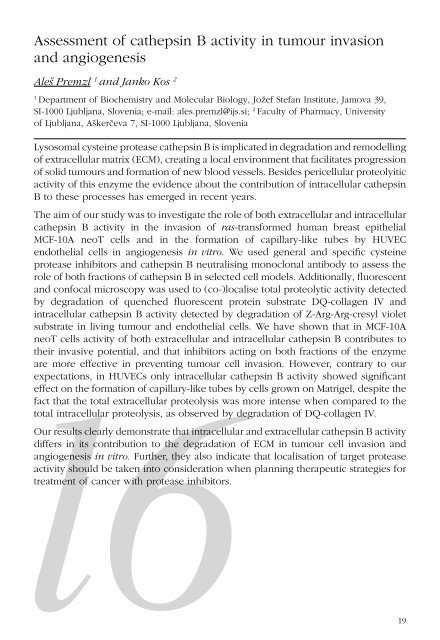You also want an ePaper? Increase the reach of your titles
YUMPU automatically turns print PDFs into web optimized ePapers that Google loves.
Assessment of cathepsin B activity in tumour invasion<br />
and angiogenesis<br />
Ale{ Premzl 1 and Janko Kos 2<br />
1<br />
Department of Biochemistry and Molecular Biology, Jo`ef Stefan Institute, Jamova 39,<br />
SI-1000 Ljubljana, Slovenia; e-mail: ales.premzl@ijs.si; 2 Faculty of Pharmacy, University<br />
of Ljubljana, A{ker~eva 7, SI-1000 Ljubljana, Slovenia<br />
Lysosomal cysteine protease cathepsin B is implicated in degradation and remodelling<br />
of extracellular matrix (ECM), creating a local environment that facilitates progression<br />
of solid tumours and formation of new blood vessels. Besides pericellular proteolyitic<br />
activity of this enzyme the evidence about the contribution of intracellular cathepsin<br />
B to these processes has emerged in recent years.<br />
The aim of our study was to investigate the role of both extracellular and intracellular<br />
cathepsin B activity in the invasion of ras-transformed human breast epithelial<br />
MCF-10A neoT cells and in the formation of capillary-like tubes by HUVEC<br />
endothelial cells in angiogenesis in vitro. We used general and specific cysteine<br />
protease inhibitors and cathepsin B neutralising monoclonal antibody to assess the<br />
role of both fractions of cathepsin B in selected cell models. Additionally, fluorescent<br />
and confocal microscopy was used to (co-)localise total proteolytic activity detected<br />
by degradation of quenched fluorescent protein substrate DQ-collagen IV and<br />
intracellular cathepsin B activity detected by degradation of Z-Arg-Arg-cresyl violet<br />
substrate in living tumour and endothelial cells. We have shown that in MCF-10A<br />
neoT cells activity of both extracellular and intracellular cathepsin B contributes to<br />
their invasive potential, and that inhibitors acting on both fractions of the enzyme<br />
are more effective in preventing tumour cell invasion. However, contrary to our<br />
expectations, in HUVECs only intracellular cathepsin B activity showed significant<br />
l6<br />
effect on the formation of capillary-like tubes by cells grown on Matrigel, despite the<br />
fact that the total extracellular proteolysis was more intense when compared to the<br />
total intracellular proteolysis, as observed by degradation of DQ-collagen IV.<br />
Our results clearly demonstrate that intracellular and extracellular cathepsin B activity<br />
differs in its contribution to the degradation of ECM in tumour cell invasion and<br />
angiogenesis in vitro. Further, they also indicate that localisation of target protease<br />
activity should be taken into consideration when planning therapeutic strategies for<br />
treatment of cancer with protease inhibitors.<br />
19
















